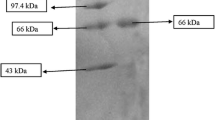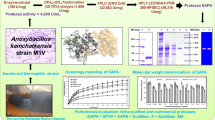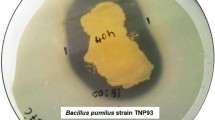Abstract
An extracellular alkaline protease from an alkalophilic bacterium, Bacillus cereus, was produced in a large amount by the method of extractive fermentation. The protease is thermostable, pH tolerant, and compatible with commercial laundry detergerts. The protease purified and characterized in this study was found to be saperior to endogenous protease already present in commercial laundry detergents. The enzyme was purified to homogeneity by ammonium sulfate precipitation, concentration by ultrafiltration, anionexchange chromatography, and gel filtration. The purified enzyme had a specific activity of 3256.05 U/mg and was found to be amonomeric protein with a molecular mass of 28 and 31 kDa, as estimated by sodium dodecyl sulfate polyacrylamide gel electrophoresis (SDS-PAGE) and nondenaturing PAGE, respectively. Its maximum protease activity against casein was found to be at pH 10.5 and 50°C. Proteolytic activity of the enzyme was detected by casein and gelatin zymography, which gave a very clear protease activity zone on gel that corresponded to the band obtained on SDS-PAGE and nondenaturing PAGE with a molecular mass of nearly 31 kDa. The purified enzyme was analyzed through matrix-assisted laser desorption ionization-time-of-flight-mass spectrometry (MALDI-TOF-MS) and identified as a subtilisin class of protease. Specific serine protease inhibitors, suggesting the presence of serine residues at the active site, inhibited the enzme significantly.
Similar content being viewed by others
References
North, M. J. (1982), Microbiol. Rev. 46, 308–340.
Walsh, K. A. and Wilcox, P. E. (1970), in Methods in Enzymology, vol. 19, Perlmann, G. E. and Lorand, L., eds., Academic, New York, pp. 31–226.
Ward, O. P. (1985), in Comprehensive Biotechnology, vol. 3, Moo-Young, M., ed., Pergamon, Oxford, pp. 789–818.
Kalisz, H. M. (1988), in Advances in Biochemical Engineering/Biotechnology, vol. 36, Fiechter, A., ed., Springer-Verlag, Berlin, pp. 1–65.
Outtrup, H. (1990), in Microbial Enzymes and Biotechnology, Fogarty, W. M. and Kelly, C. T., eds., Elsevier Science, New York, pp. 227–254.
Godfrey, T. and Reichelt, J. (1985), in Industrial Enzymology, Godfrey, T. and West, S., eds., Nature Press, London.
Rao, M. B., Tanksale, A. M., Ghatge, M. S., and Deshpande, V. V. (1998), Microbiol. Mol. Biol. Rev. 62, 597–635.
Wolff, A. M., Showell, M. S., Venegas, M. G., Barnett, H. L., and Wertz, W. C. (1993), in Subtilisin Enzymes: Practical Protein Enginerring, Boltz, R. and Betzel, C., eds., Plenum, New York, pp. 113–120.
Banerjee, U. C., Sani, R. K., Azmi, W., and Sani, R. (1999), Process Biochem. 35, 213–219.
Singh, J., Batra, N., and Sobti, R. C. (2001), Process Biochem. 36, 781–785.
Dhandapani, R. and Vijayaragvan, R. (1994), World J. Microbiol. Biotechnol. 10, 33–35.
Feng, Y. Y., Yang, W. B., Ong, S. L., Hu, J. Y., and Ng, W. J. (2001), Appl. Microbiol. Biotechnol. 57, 153–160.
Kobayashi, T., Hakamada, J., Hitomi, J., Koike, K., and Ito, S. (1996), Appl. Microbiol. Biotechnol. 45, 63–71.
Banik, R. M. and Prakash, M. (2004), Microbiol. Res. 159, 135–140.
Lee, Y. H. and Chang, H. N. (1990), J. Ferment. Bioeng. 69, 89–92.
Hotha, S. and Banik, R. M. (1997), J. Chem. Tech. Biotechnol. 69, 5–10.
Hagihara, B, Matsubara, H., Nakai, M., and Okumuki, K. (1958), J. Biochem. 45, 185–194.
Bradford, M. M. (1976), Anal. Biochem. 72, 248–254.
Laemmli, U. K. (1970), Nature 227, 680–685.
Oliver, G. W., Stetler-Stevenson, W. G., and Kleiner, D. E. (1999), in Proteolytic Enzymes: Tools and Targets, Sterchi, E. and Stöcker, W., eds., Springer-Verlag, Berlin, pp. 63–76.
Leber, T. M. and Balkwill, F. R. (1997), Anal. Biochem. 249, 24–28.
Shevchenko, A., Wilm, M., Vorm, O., and Mann, M. (1996), Anal. Chem. 68 (5), 850–858.
Jobin, M. C. and Grenier, D. (2003), FEMS Microbiol. Lett. 220, 113–119.
Thangam, E. B. and Rajkumar, G. S. (2002), Biotechnol. Appl. Biochem. 35, 149–154.
Kuhn, P., Knapp, S., Michael, S., Ganshaw, G., Thoene, M., and Bott, R. (1998), Biochemistry 37, 13,445–13,452.
Author information
Authors and Affiliations
Corresponding author
Rights and permissions
About this article
Cite this article
Prakash, M., Banik, R.M. & Koch-Brandt, C. Purification and characterization of Bacillus cereus protease suitable for detergent industry. Appl Biochem Biotechnol 127, 143–155 (2005). https://doi.org/10.1385/ABAB:127:3:143
Received:
Revised:
Accepted:
Issue Date:
DOI: https://doi.org/10.1385/ABAB:127:3:143




